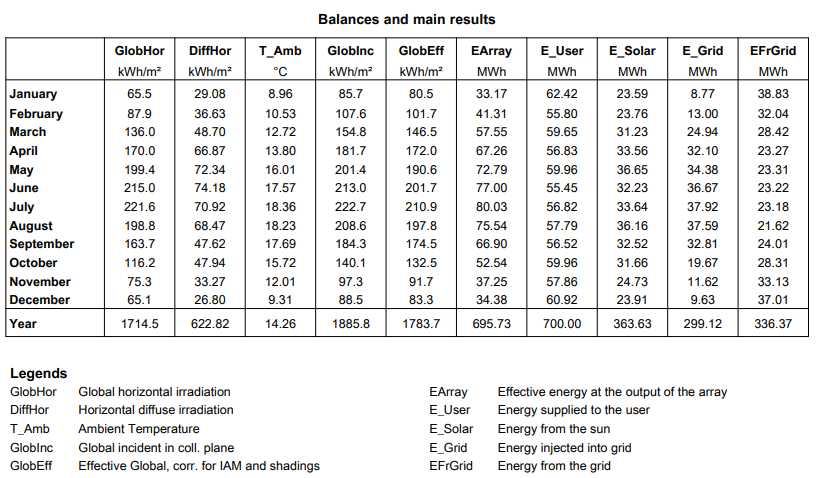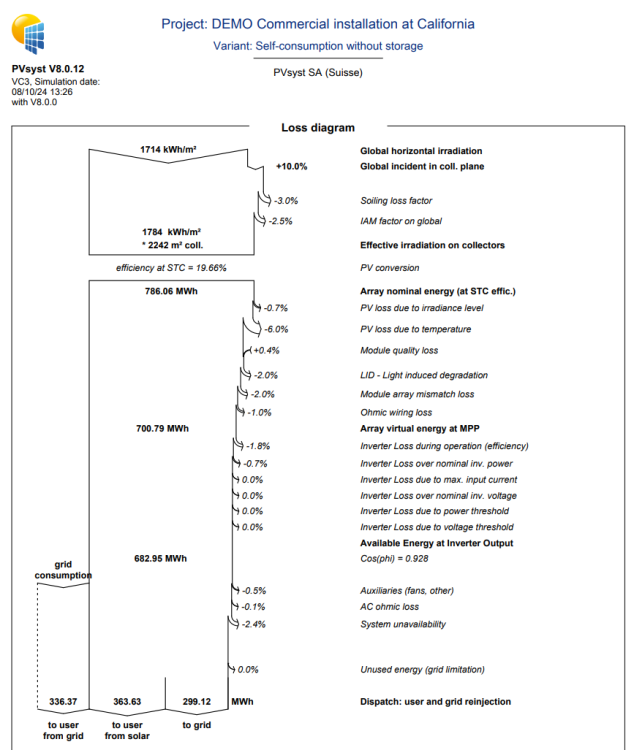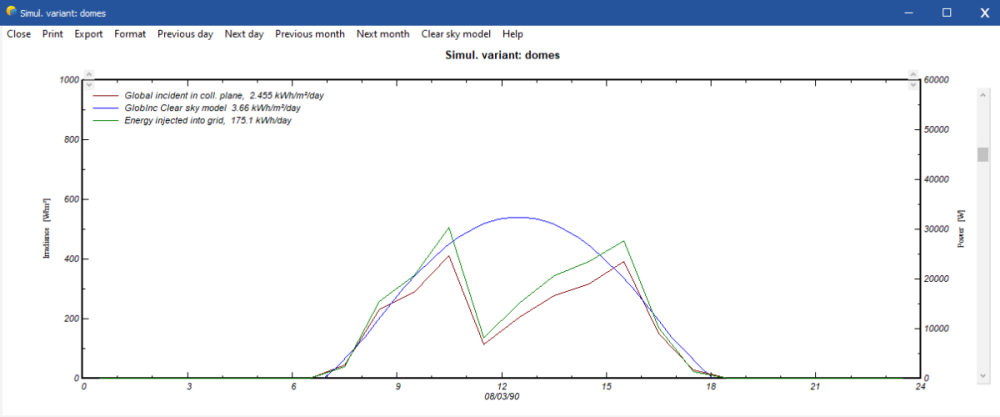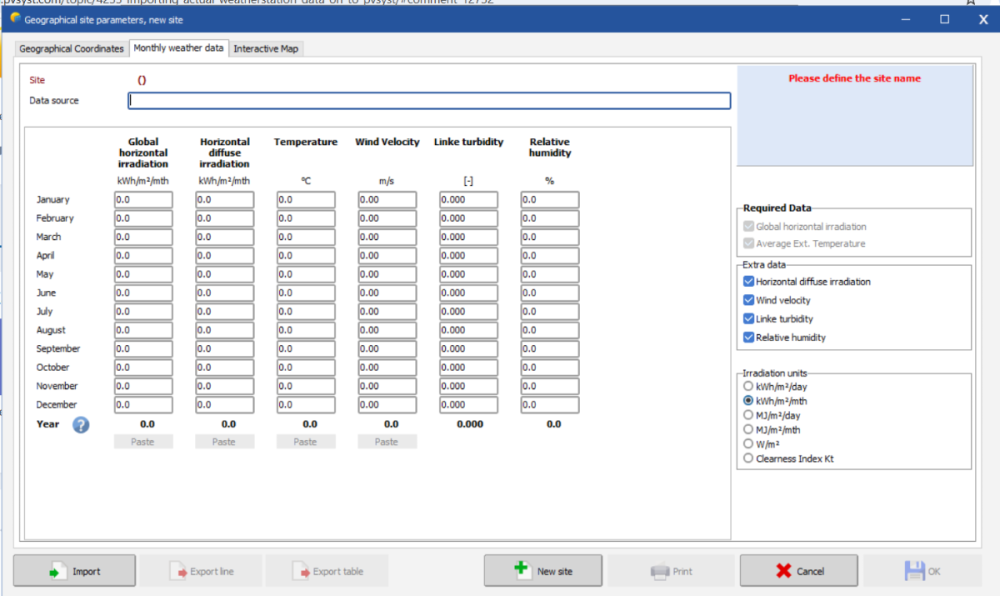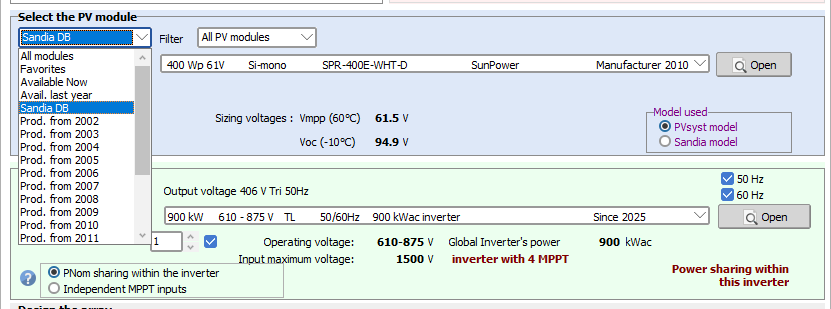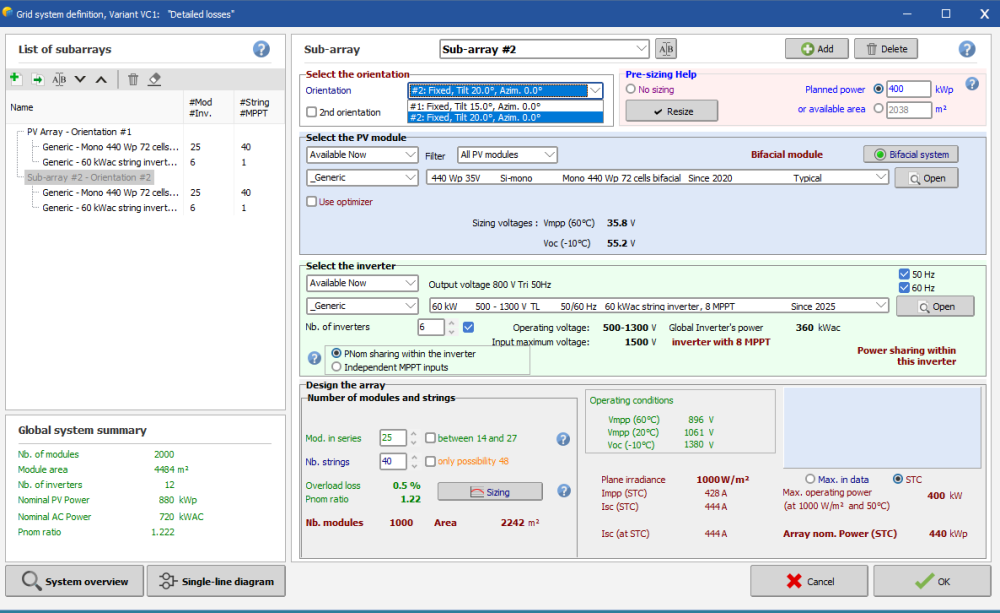-
Posts
297 -
Joined
-
Last visited
Everything posted by Linda Thoren
-
In general, the denomination of a given time interval in PVsyst is always defined as the beginning of this interval. This is valid for hourly, daily or monthly values. For meteo data, the time stamp is the time interval over which the irradiance measurement (or any other value) is averaged. For example, the time stamp 11:00 corresponds to measurements averaged between 11:00 and 12:00. When using irradiance models, the solar geometry should be calculated for an "average" of the time interval. PVsyst uses the middle of this time interval (in the previous example 11:30). Different weather data providers have their own definition of the timestamp and thus will be adapted to match the one in PVsyst.
-
Hello, A floating system is rather similar to a conventional PV system. Following forum post describes how you can adapt your simulation to a floating PV system: To start a PVsyst project, we have several tutorials in PDF and on youtube: https://www.pvsyst.com/wp-content/pdf-tutorials/pvsyst-tutorial-v8-grid-connected-en.pdf
-
Hello, Yes, the zone tool will be improved in a future version. In the meantime, by defining a fixed tilted plane with the all the parameters you wish for your trackers (orientation, pitch, size etc.) and tick the option "Create tracking fields" (as you have done in image 4), the zone will be filled with trackers with the correct definition.
- 1 reply
-
- orientation
- 3d scene
-
(and 2 more)
Tagged with:
-
Hello Johann, The simulation and corresponding energy balance are calculated using hourly time steps. To determine how much of the generated solar energy can be self-consumed, the simulation must be run. For example, in the DEMO project “DEMO Commercial Installation at California” (VC3), the report shows: E_User: the total energy delivered to the user (reflecting the self-consumption profile), E_Solar: the portion of E_User that is covered by solar production, EFrGrid: the remaining energy that must be imported from the grid to meet the user's demand, E_Grid: any excess solar energy that is injected into the grid. These values are also illustrated in the annual loss diagram, giving a complete overview of the system’s performance over the year. Best regards
-

Daily generation profile Irregularities
Linda Thoren replied to JamesLenton's topic in Problems / Bugs
Indeed it seems a bit surprising that the global irradiance would be 0 for a few hours in the middle of the day, but indeed possible. Using another weather data provider, do you see similar drops in irradiance? If you import a weather file with missing data, these hours will be considered as 0 in PVsyst. -

Daily generation profile Irregularities
Linda Thoren replied to JamesLenton's topic in Problems / Bugs
Hello, To better understand the results, you can consider adding additional parameters—such as irradiance—to assess whether a drop in production is due to variations in weather data or other factors. In the Advanced Simulations, you also have the option to export hourly data as a .csv file, allowing for deeper analysis of any relevant simulation parameters. -
Dear Ihr, The Global horizontal irradiation is transformed to global incident in collector plane by using a transposition model. You can read more about the transposition model in the following PVsyst help page: https://www.pvsyst.com/help/physical-models-used/irradiation-models/transposition-model.html?h=transpositio The Global on collector plane from the Quick optimization box in the orientation window is based on the clear sky model at your site and is not the result of the simulation but serves as a quick optimization to get an order of magnitude of the irradiance in the collector plane according the chosen tilt and azimuth. The GlobInc in the report is the result of the simulation based on the hourly weather data.
-

PVGIS hava durumu verilerini getirme hatası
Linda Thoren replied to Hakan Öztürk's topic in Meteo data
Hello Hakan öztürk, Please note that this forum is in English. In December, PVGIS modified their format for the TMY output, which has affected the functionality of our API. The data reading was updated in version 8.0.6. Please update to a more reason PVsyst version and this should solve your issue. -
Hello! You should divide your 10 years of data into 10 different files, one for each year. Then you can generate a TMY weather filed based on these 10 individual year in the TMY generation tool. In your workspace, you find a template for the PVsyst standard file, double check comparing to this file that you are following the requirements. You can also import your file as a Custom file is you continue having issues with the known format.
-

Importing actual weatherstation data on to PVsyst
Linda Thoren replied to Sydwell's topic in Meteo data
Hello Kadi1, Indeed the simulation will be done for maximum a year, thus the weather data can not contain data for more than a year. The simulation will be done with hourly time steps, so to use the custom file you need to have hourly values. Do you have daily averages? You could possibly create monthly averages based on all the years of data that you avail, and create a synthetic data file based on the monthly averages. This can be done but creating a new site and fill in the Monthly weather data: -
Hello Marija, Indeed, the only possibility is to apply a grid limit for the full system. As you suggest, a workaround would be to create a variant for each sub-system and aggregate the results. I will note your use-case for possible future development of for instance having the possibility to define the limitation per sub-array (as for the ohmic losses for instance). Thank you reaching out
-
Hi, The number of inverters shouldn't impact the workaround since it was defined by the power triangle in the case of a single inverter.
-
Hello, You have an explanation in the blue square in the upper right corner. In sub-array #3 you have 15 MPPTs, in a configuration of 18 inverters, thus it is not a multiple between the number of MPPTs and number of inverters. Of the 18 inverters, some would have 1MPPT from this sub-array and other would have 2, this must be premised when defining the sub-arrays and the configurations. The use of the Power sharing tool is further explained in the following tutorial:
-
In PVsyst you have the possibility to import weather data from various weather data providers. If you are using the same weather data, indeed the Global horizontal irradiation will identical.
-
Hello, Since the the power limitation is either in active or reactive power in PVsyst, adjusting the .OND file is indeed necessary to properly account for the inverter’s behavior at pf=0.85. In the output parameters in the .OND file, choose Apparent power and adapt the Nominal AC Power to 140 kVA in the Main parameters window. Make sure you rename the model and the file name to be used only in projects with a pf < 0.89 Regards,
-
Hello, The Sandia model is only an option for panels in the Sandia database. You can choose to filter the Sandia Database among the available panels and there you have an option to change to the Sandia model. In your print screen, you have defined the First Solar Spectral correction. By default PVsyst propose no spectral correction for crystalline modules
-
Hello, If the domes are placed along the tilted roof, you can simply add a "baseline slope" of 2° and the domes will follow the roof: In the case the domes would be placed perpendicular to the slope, it is less straight foreword. - By creating an array of domes, right click on the array and "ungroup", then mark all the tables and in the "Scene object", right click and use the "automatic altitude option". This is the alternative to right in the image, where the pair of domes are horizontal, though each pair are following the tilt of the roof. - By creating an array of domes, right click and "convert to domes to fixed tables", then mark all the tables and in the "Scene object", right click and use the "automatic altitude option". The altitude for each table will then precisely follow the tilt of the roof, though the tilt of the panels should be adapted to arrive compensate for the tilted roof. In the "list and management of objects (Ctrl+G), add 2 degrees to the tilt for the lower panels, and reduce the tilt with 2° for the upper panels. This is the alternative to the left in the image. I hope this answers your question
-
Hi, Indeed you should check the multi-MPPT feature and click on the Power sharing button to activate the power sharing feature (drag the sub-array from the list to the right to the configuration to the left). By defining this correctly, it would be expected to decrease the overload loss over nominal inverter power.
-
Hello, 1/ It is important that you have a multiple between the number of strings and number of MPPT inputs so that PVsyst can equally distribute the strings over the MPPTs, since there is no power sharing within the sub-array, only between the sub-arrays. 2/ I understand that your inverter has 12 MPPTs, some MPPTs with 2 strings and others with 1 strings, some with 18 panels in series and others with 19. You can either define each MPPT individually in separate sub-arrays: - 1st sub-array with 2 strings of 18 panels - 2nd the same - 3rd sub-array 1 string of 18 - etc. Or you can group all the MPPTs with the same configuration in the same sub-array, for instance: - 1st sub-array with 3 MPPTs with 6 strings of 18 - 2nd sub-array with 3 MPPTs and 3 strings of 18 (just to highlight here that it would not be correct to define 6 MPPTs with 9 strings of 18, since it would not be a multiple between the number of MPPTs and number of strings) - 3rd sub-array with 5 MPPTs with 5 strings of 19 - 4th sub-array with 1 MPPT with 2 strings of 19 If you have 11 inverters with the same configuration, you can multiply the number of MPPTs and the numbers of strings in each sub-array with 11 (33 MPPTs and 66 strings in the first sub-array etc.) I hope this clarifies the use of the Power sharing feature. You find more examples in the following youtube tutorial:
-
Hello, Indeed, the first input of the Global horizontal irradiation is different between the two diagrams. Verify that you have the same coordinates and are using the same weather data provider.
-

orientation Pamareters Pvsyt 8
Linda Thoren replied to mohamed abdelkader's topic in Shadings and tracking
Hi, It seems like you have defined an orientation (Orientatation #2) that has not been defined in the system. In the system window, make sure that all the orientations (shown in the drop down list) has been assigned in a sub-array (list of subarrays to the left)


